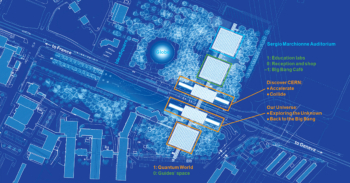Norbert Holtkamp extols the virtues of blogging as a way to encourage dialogue on important issues.

Image credit: SLAC.
It all started a year ago over dinner with a good bottle of wine in front of us. Steve Gourlay of Lawrence Berkeley National Laboratory, Stuart Henderson of Fermilab and myself talked about the future of accelerator R&D in the US and what could be done to promote it.
We had no idea that an opportunity would present itself so quickly, that it would require such fast action or that blogging would be a central part of carrying out our mission.
A 2009 symposium called “Accelerators for America’s Future” had laid out some of the issues and obstacles, and in September 2011 the US Senate Committee on Appropriations asked the US Department of Energy (DOE) to submit a strategic plan for accelerator R&D by June 2012.
The DOE asked me to lead a task force to develop ideas about this important matter: what should the DOE do, over the next 10 years, to streamline the transfer of accelerator R&D so that its benefits could spread out into the larger society?
We were ready to go by October. The task force would have until 1 February 2012 – just four months – to identify research opportunities targeted to applications, estimate their costs and outline the possible impediments to carrying out such a plan. Based on this information, DOE officials would draw up their strategic plan in time for the congressional deadline.
It was a huge job. The 15 members of the task force, who hailed from six DOE national laboratories, industry, universities, DOE headquarters and the National Science Foundation, would need to gather facts, opinions and ideas from a range of people with a stake in this issue – from basic researchers at the national laboratories to university and industry scientists, entrepreneurs, inventors, regulators, industry leaders, defence agencies and owners of businesses both small and large.
We quickly held a workshop in Washington, DC, followed by others at the Argonne and Lawrence Berkeley National Laboratories, where we presented some of the major ideas. And to gather the most feedback from the most people in the shortest amount of time, I did something that I like to do: I started a blog.
Now, anyone who has been around high-energy physics for a while knows that blogs and other forms of cutting-edge social media are nothing new. We particle physicists, after all, started the World Wide Web as a way to share our ideas, and what became known as the arXiv to distribute preprints of our research results. Many physicists are avid bloggers, and a number of laboratories – from CERN to Fermilab and KEK – operate blogs of their own; you can see a sample of these blogs at www.quantumdiaries.org. But it’s not as usual to incorporate a blog into the work of a task force – although, for the life of me, I don’t know why you would not want to do it.
One of the first things that I did when I came to SLAC two years ago was to start a blog aimed at fostering communication among people in the Accelerator Directorate. A blog is a great way to talk about topics that are burning under our fingernails – although sometimes one needs to overcome a certain amount of cultural resistance to get people talking freely. Instead of filling various inboxes with chains of e-mails, “electronic blackboards” are easy to read and easy to post on, and they even have the added convenience of notifying you when a new post goes up.
In the good old days you could have everyone come to one place and have a panel discussion or an all-hands meeting – an easy, free-flowing exchange of ideas. A blog can be just such a thing: open and inviting.
Our task force invited literally thousands of people to comment on the issues at hand. What can be done to move the fruits of basic accelerator research and development more quickly into medicine, energy development, environmental cleanup, industry, defence and national security? What good could flow from such a movement? What are the barriers – especially between the national laboratories, where most of this research is done, and the industries that could develop it into products – and how can they be overcome?
Not everyone answered, but many did. More than half of the responses that we got came in through the blog rather than as e-mail messages. Within a couple of days it became clear just from the people who blogged that the medical community is starving for facilities and infrastructure to develop radiation therapy further, mainly with heavy-ion beams. The people talked to us and among themselves. So it’s no surprise that the report we write will describe opportunities for the DOE to make its infrastructure available for researchers who want to pursue this line of work.
Others talked about the difficulties that they had in working with government agencies or national laboratories and how this could be made easier – a worthwhile read during an easy afternoon.
So, blogging is not just fun; it’s a great way to gather information and encourage dialogue. Once our task force finalizes its report, the site will be up for a while, and then, when the next issue arises, the blackboard will get cleaned and I will start a new one.
• To see the blog, go to https://slacportal.slac.stanford.edu/sites/ad_public/committees/Acc_RandD_TF_Blog/default.aspx.





